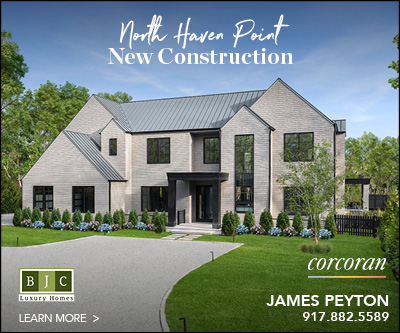Have you ever wondered what makes some homes look so special? In a neighborhood of houses, some stand out from the crowd. It doesn’t always have to do with size or location. Some properties just look pulled together — the house and grounds unite into a seamless whole. What’s probably going on is that the landscape has been carefully crafted to suit the house. When the landscape is in tune with the house, the result is a garden that feels like home. It happens from a unity of styles — a formal landscape surrounding a formal home, or a casual country garden next to an informal, relaxed house. Matching the style of your landscape is one important way to unify house and grounds. Another way is through color.
 The purple, green and white color scheme of the garden harmonizes beautifully with the blue trim and gray walls of the house.
The purple, green and white color scheme of the garden harmonizes beautifully with the blue trim and gray walls of the house.
The first step in coordinating colors between your house and landscape is to go outside and take a good look at the house. Then create garden and landscape elements — flowers, of course, but also structures like fences and gates, arbors and awnings, even pots on a deck or patio — that connect with the colors of the house.
Start with the Walls. Look first at the walls of the house, and choose garden colors to harmonize with it or contrast pleasingly. Wall color is created by building materials, such as brick, stone, or wood, and by colored paint, siding, or stucco applied to the walls. If the walls of your house are a neutral color, such as off-white, gray, or taupe, your garden can be practically any color. You can also take color cues from the warmth or coolness of the neutral color of the walls. For example, with a gray house you might like the look of cooler colors such as purples, blues and cool pinks, or perhaps some deep burgundy or rich red. With beige walls you might find that you like warmer colors in the garden — warm pinks, or orangey reds, red-violets, or maybe rich royal purples. A brick house can be beautifully complemented by sunset colors — reds, oranges and yellows.
Look at the trim. One of the best ways to link house and grounds is through the trim around windows and doors, or the colors of doors and shutters. You can echo the trim colors on the house in the flowers in the garden or architectural elements in the landscape. For instance, you might pick up the color of your front door or shutters in a pot of flowers on the front steps, or in a gate or fence rails, or a gazing globe or birdhouse out in the garden. You can repeat a color from the house in an arbor or gazebo. You could even extend your indoor color scheme outdoors, so your indoor space flows visually into your outdoor space. This works especially well on decks and patios, where you can choose seat cushions and tablecloths to echo your indoor color scheme.
The key to it all is to step back and look at your house, and the elements of your landscape, even accessories, and unite them in a coordinated color theme. It can give your place a whole new look and feeling.
Adapted from Homescaping: Designing Your Landscape to Match Your Home, by Anne Halpin (Rodale Press)
Writer, editor and author Anne Halpin has published 17 books on gardening and related subjects and edited many more. She has been living and gardening on the East End of Long Island for 23 years, and has cared for many private gardens here.









![Drawing inspiration from the Greek Revival style of architecture, 7 Somers Place was developed by Sag Harbor master builder, Robert Tortora. The gracious living room with mantled masonry fireplace and elevated ceilings flows to the spacious dining room and custom light-filled kitchen. Represented by @thechrisritchey and Kim Hovey of @compass. [link in bio]](https://hamptonsrealestateshowcase.com/wp-content/uploads/sb-instagram-feed-images/488012730_18501545716030135_2576407923807360973_nfull.webp)
![Elegance and intelligence abound at this waterfront masterpiece with 8,065± sq ft, 7 bedrooms and 8.5 baths. 101 Jessup Lane boasts a sweeping double stairway entry hallway, 7 romantic fireplaces, a large gathering room, formal dining room, billiard room, and exercise room with sauna. Represented by @rydbergkent of @douglaselliman. [link in bio]](https://hamptonsrealestateshowcase.com/wp-content/uploads/sb-instagram-feed-images/486626595_18501344173030135_6414454892538890571_nfull.webp)
![Discover fabulous floral finds and nature-inspired treasures to bring beauty and charm to your life. Whether you’re adding a touch of nature to your home or finding the perfect gift, these blooming delights are sure to brighten your day! [link in bio]](https://hamptonsrealestateshowcase.com/wp-content/uploads/sb-instagram-feed-images/487711988_18500839267030135_4881948075500906108_nfull.webp)
![Spring, of course, leads inexorably into another summer season here in the Hamptons. According to agents we spoke to, demand is quite strong this year for rentals. A quality medium-priced property, well presented with amenities, is eagerly sought-after. Publicly listed rentals range from a high of $2.5 million, Memorial Day to Labor Day, on Cobb Lane in Water Mill, with quite a few more $1 million plus rentals than usual. [link in bio]](https://hamptonsrealestateshowcase.com/wp-content/uploads/sb-instagram-feed-images/486541532_18500603206030135_1827695170316201968_nfull.webp)
![Perched atop the dunes at Louse Point sits a picturesque house, perfect for enjoying all seasons that East Hampton has to offer. Situated on three quarters of an acre with almost 360 degree views of Gardiner’s Bay and Accabonac Harbor, 86 & 88 Louse Point are truly unique. Represented by @petrieteam of @compass. [link in bio]](https://hamptonsrealestateshowcase.com/wp-content/uploads/sb-instagram-feed-images/486615712_18500408650030135_1498783920053065135_nfull.webp)
![Set to be completed this year, this extraordinary property spans 2.5± acres of cleared land and showcases over 12,125± sq. ft. of architectural sophistication and refined design. With 9 bedrooms, 11 full baths, and 2 half baths, 261 Millstone Road offers an exceptional blend of spaces for both relaxation and entertainment. Represented by @susan.breitenbach of @thecorcorangroup. [link in bio]](https://hamptonsrealestateshowcase.com/wp-content/uploads/sb-instagram-feed-images/486599655_18500185618030135_8926656954621895711_nfull.webp)

![If you are a buyer searching for an exclusive, brand-new mid or high-rise residence in Naples, Florida, Mystique 601 cannot be missed. Expansive floor-to-ceiling windows invite abundant natural light, seamlessly blending indoor and outdoor living with breathtaking Gulf views. Represented by Mark Riley of @luxepropertiesmia. [link in bio]](https://hamptonsrealestateshowcase.com/wp-content/uploads/sb-instagram-feed-images/486018213_18499791688030135_1711217068426589475_nfull.webp)
